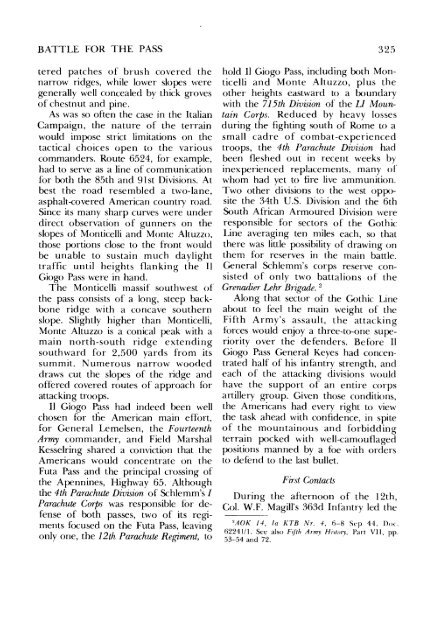Cassino to the Alps - US Army Center Of Military History
Cassino to the Alps - US Army Center Of Military History
Cassino to the Alps - US Army Center Of Military History
You also want an ePaper? Increase the reach of your titles
YUMPU automatically turns print PDFs into web optimized ePapers that Google loves.
BATTLE FOR THE PASS<br />
tered patches of brush covered <strong>the</strong><br />
narrow ridges, while lower slopes were<br />
generally well concealed by thick b'Toves<br />
of chestnut and pine.<br />
As \-vas so often <strong>the</strong> case in <strong>the</strong> Italian<br />
Campaign, <strong>the</strong> nature of <strong>the</strong> terrain<br />
would impose strict limitations on <strong>the</strong><br />
tactical choices open <strong>to</strong> <strong>the</strong> various<br />
commanders. Route 6524, for example,<br />
had <strong>to</strong> serve as a line of communication<br />
for both <strong>the</strong> 85th and 91 st Divisions. At<br />
best <strong>the</strong> road resembled a two-lane,<br />
asphalt-covered American country road.<br />
Since its many sharp curves were under<br />
direct observation of gunners on <strong>the</strong><br />
slopes of Monticelli and Monte Altuzzo,<br />
those portions close <strong>to</strong> <strong>the</strong> front would<br />
be unable <strong>to</strong> sustain much daylight<br />
traffic until heights flanking <strong>the</strong> II<br />
Giogo Pass were in hand.<br />
The Monticelli massif southwest of<br />
<strong>the</strong> pass consists of a long, steep backbone<br />
ridge with a concave sou<strong>the</strong>rn<br />
slope. Slightly higher than Monticelli,<br />
Monte Altuzzo is a conical peak with a<br />
main north-south ridge extending<br />
southward for 2,500 yards from its<br />
summit. Numerous narrow wooded<br />
draws cut <strong>the</strong> slopes of <strong>the</strong> ridge and<br />
offered covered routes of approach for<br />
attacking troops.<br />
II Glogo Pass had indeed been well<br />
chosen for die American main effort,<br />
for General Lemelsen, <strong>the</strong> Fourteenth<br />
<strong>Army</strong> commander, and Field Marshal<br />
Kesselring shared a conviction that <strong>the</strong><br />
Americans would concentrate on <strong>the</strong><br />
Futa Pass and <strong>the</strong> principal crossing of<br />
<strong>the</strong> Apennines, Highway 65. Although<br />
<strong>the</strong> 4th Parachute Division of Schlemm's I<br />
Parachute Corps was responsible for defense<br />
of both passes, two of its regiments<br />
focused on <strong>the</strong> Futa Pass, leaving<br />
only one, <strong>the</strong> 12th Parachute Regiment, <strong>to</strong><br />
325<br />
hold II Giogo Pass, including both Monticelli<br />
and Monte Altuzzo, plus <strong>the</strong><br />
o<strong>the</strong>r heights eastward <strong>to</strong> a lxmndary<br />
with <strong>the</strong> 715th Division of <strong>the</strong> Ll Mountain<br />
Corps. Reduced by heavy losses<br />
during <strong>the</strong> fighting south of Rome <strong>to</strong> a<br />
small cadre of combat-experienced<br />
troops, <strong>the</strong> 4th Parachute Division had<br />
been fleshed out in recent weeks by<br />
inexperienced replacements, many of<br />
whom had yet <strong>to</strong> fire live ammunition.<br />
Two o<strong>the</strong>r divisions <strong>to</strong> <strong>the</strong> west opposite<br />
<strong>the</strong> 34th U.S. Division and <strong>the</strong> 6th<br />
South African Armoured Division were<br />
responsible for sec<strong>to</strong>rs of <strong>the</strong> Gothic<br />
Line averaging ten miles each, so that<br />
<strong>the</strong>re was little possibility of drawing on<br />
<strong>the</strong>m for reserves in <strong>the</strong> main battle.<br />
General Schlemm's corps reserve consisted<br />
of only two battalions of <strong>the</strong><br />
Grerwdier Lehr Brigade. 2<br />
Along that sec<strong>to</strong>r of <strong>the</strong> C"othic Line<br />
about <strong>to</strong> feel <strong>the</strong> main weight of <strong>the</strong><br />
Fifth <strong>Army</strong>'s assault, <strong>the</strong> attacking<br />
f()rces would enjoy a three-<strong>to</strong>-one superiority<br />
over <strong>the</strong> defenders. Before II<br />
Giogo Pass General Keyes had concentrated<br />
half of his infantry strength, and<br />
each of <strong>the</strong> attacking divisions would<br />
have <strong>the</strong> support of an entire corps<br />
artillery group. Given those conditions,<br />
<strong>the</strong> Americans had every right <strong>to</strong> view<br />
<strong>the</strong> task ahead with confidence, in spite<br />
of <strong>the</strong> mountainous and forbidding<br />
terrain pocked with well-camouflaged<br />
positions manned by a foe with orders<br />
<strong>to</strong> defend <strong>to</strong> <strong>the</strong> last bullet.<br />
First Contacts<br />
During <strong>the</strong> afternoon of <strong>the</strong> 12th,<br />
Col. W.F. Magill's 363d Infantry led <strong>the</strong><br />
'AOK 14, fa KTB Nr. 4. 6-8 Sep 44, DOL<br />
62241/1. See also Fifth <strong>Army</strong> Hislory. Part VII, pp.<br />
53-54 and 72.
















